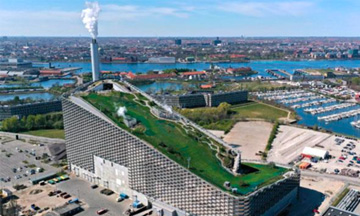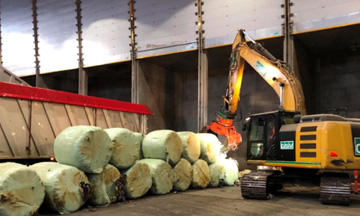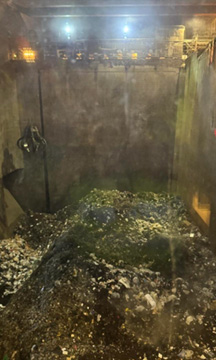In January 2024, Professors Willy Shih and Mike Toffel led 45 HBS MBA students on site visits to witness the energy transition and innovative sustainable production activities throughout Denmark and the Netherlands, in the second year of their Immersive Field Course (IFC). This is one of nine student essays that highlight their reflections.
As part of our Immersive Field Course at the Harvard Business School, our class had the chance to visit Amager Bakke, a waste-to-power site in Copenhagen that safely and responsibly turns waste from the city and surrounding area into a heat and electric power source. Amager Bakke is located within eyeshot of downtown Copenhagen, and despite being an industrial waste management and energy production site, serves as a community gathering point. With the world’s tallest rock-climbing wall along one side of the building (standing at a daunting 82 meters tall!), a usable ski hill around and down the periphery, and space for the public to convene and relax overlooking the cityscape, Amager Bakke redefines both what an energy production site can do, and how it can be integrated into the community.

About Amager Bakke
Initially built to replace a 45-year-old waste incineration plant, construction of Amager Bakke began in 2013 and was completed in 2017 at a cost of €470m ($611m). The plant is publicly owned by five Copenhagen-area municipalities.
CEO Jacob Simonson led a presentation for our group on how the facility functions within the Copenhagen ecosystem. Amager Bakke provides residents with a dual service: waste collection and energy production. Receiving trash from approximately 600,000 citizens and 68,000 businesses, private homes account for 50% of the combustible waste provided. Waste is also occasionally imported from countries as far away as Italy, as the environmental impact of waste incineration at Amager Bakke is more attractive than local options such as landfills (even factoring in emissions associated with transporting it that distance). Only residual waste is incinerated—consumers sort trash into up to ten diferent streams including food waste, plastic, cartons, glass, cardboard, electronics, metal, paper, textiles, and residual waste. In 2023, the facility received 590,000 tons of waste which was transformed into 283 GWh of electricity (powering roughly 94,000 households) and 1,300 GWh of heating (providing heat for 87,000 apartments).
Around 300 trucks arrive daily to unload trash into a 22,000-ton silo where two mechanical claws mix and lift the waste into the incinerator. The two incinerators can process up to 42 tons per hour at temperatures as high as 1,100°C (2000°F). The exhaust stream reaches twin boilers which produce high pressure steam. The steam powers a turbine that generates electricity. Residual ash and slag are turned into a cement-like byproduct used in construction.


Amager Bakke earns several revenue streams: residents pay Amager Bakke for waste removal, Amager Bakke sells its generated electricity to the Copenhagen grid, and it sells heat to the city for its district heating operation. In short, Amager Bakke provides Copenhagen a clean option to reduce municipal trash (and even help neighboring countries with waste disposal) and a source of power that is relatively low cost, predictable, and sustainable.
The exhaust stream also includes carbon dioxide, and Amager Bakke began piloting a carbon capture system in 2021. The current system can capture 160 kg of CO2 per hour, or up to 4 metric tons of CO2 per day. The captured CO2 is cooled and stored in tanks, and can either be stored underground, converted into green fuels, or sold to local greenhouse vegetable growers.

Takeaways from Our Visit
Our visit to Amager Bakke provided numerous insights into modern, innovative, and sustainable waste management. Notably, the facility follows several best practices to maximize the sustainability of its operations like first extracting recyclables such as paper, glass, and metals, aligning with circular economy principles by conserving resources and only incinerating non-recyclable combustible waste. Flue gas cleaning systems are used to limit emissions from the combustion process, and continuous emissions monitoring and a high-tech control room enable close oversight of environmental performance. The leftover bottom ash is utilized for road construction, demonstrating how material resources can be recovered after energy extraction.
The facility has been creatively integrated into the community, providing recreational and aesthetic benefits for locals beyond waste management. We were impressed to learn that local apartment listings are even highlighting proximity to the facility to make their properties more desirable. By winning the Danish public’s approval, Amager Bakke advances the agenda of educating the public around sustainable waste practices to drive a virtuous cycle where citizens become more conscious of their own footprints and are empowered to reduce and sort waste at the source.
Centralized waste processing and district heating provide economies of scale in a carbon-efficient urban system. By managing waste for over 1 million inhabitants, Amager Bakke is a landmark for sustainability across Copenhagen. The plant exemplifies innovative waste-to-energy that maximizes environmental and social outcomes through responsible design and operation.

